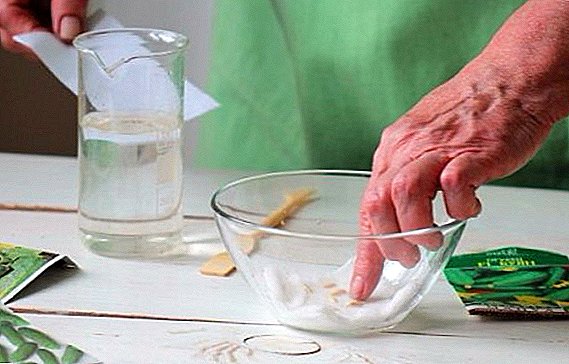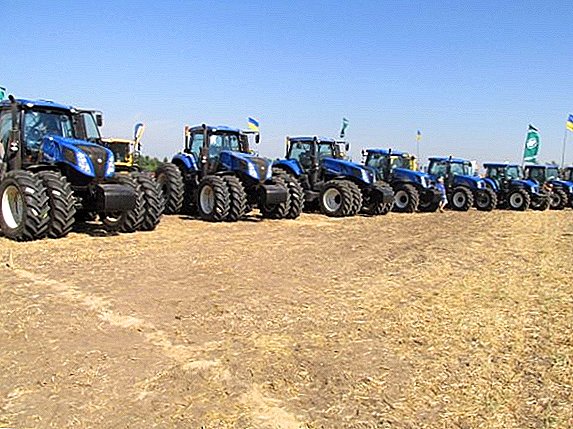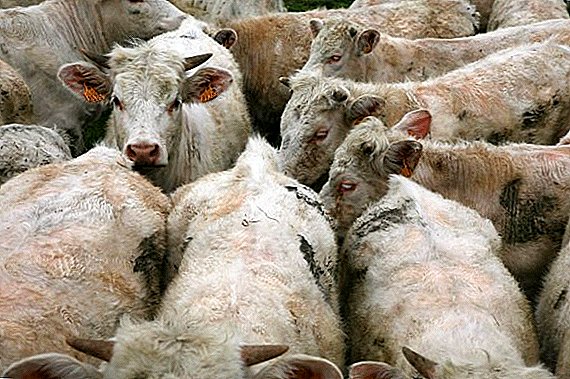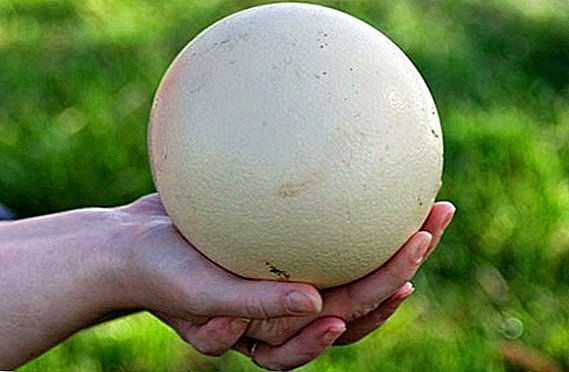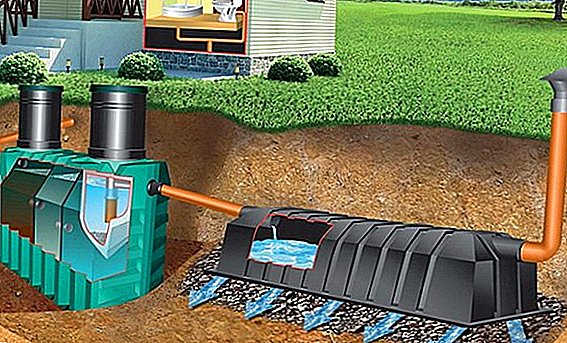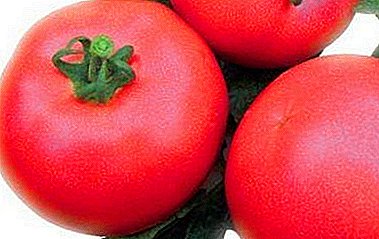
Among the fruit crops grown in our country, the most common is an apple tree, namely dwarf representative.
And not only here, but all over the world, these squat trees have long supplanted their tall predecessors.
Such changes were quite natural.
Firstly, vigorous apple trees occupy a large plot of land with their crown.
Also, care for them takes a lot of effort, and proper processing and pruning will not work, again, because of the large size.
Overtaking their ineffective relatives, dwarf apple tree gained massive popularity. One of the representatives of these trees is apple varieties Sokolovsky, which will be discussed later. Description of the variety and photos in the article.
What kind is it?
 Sokolovskoye is a winter varietyand, therefore, has all the advantages of this category, namely, its fruits can be consumed year-round, they unpretentious during transportation and storage.
Sokolovskoye is a winter varietyand, therefore, has all the advantages of this category, namely, its fruits can be consumed year-round, they unpretentious during transportation and storage.
By the way, those who tried to find information on the storage of winter varieties of apples managed to make sure that it was difficult to implement the recommendations offered by the specialists.
Not all gardeners have the opportunity to allocate a separate room for each variety, where individual temperature and humidity indicators would be maintained.
At the disposal of an ordinary gardener, you can expect only a cellar or basement, in which a moisture indicator, thermometer or equipment for monitoring microclimatic parameters is unlikely to be found.
The only trick is the ventilation system, and even that is not automatic.
Meet other winter varieties of apple trees: Granny Smith, Winter Pear, Aydared, Antonovka dessert, Stroyevskoe, Fuji, Lobo, Kuibyshevskoe, Phoenix Altai.
And now to the really helpful tips:
Choose a place where the temperature is in winter in the range of -1 ° - + 5 ° and fluctuates no more than two degrees. The influence of strong drops is detrimental, so you have to sort out the fruits right in the basement.
For storage use boxes made of wood, plywood or plastic, by which apples are sorted according to size. Small boxes are preferable: they are easier to move.
It will be safer to shift the fruit with chips, sawdust, straw, in their absence: with newspapers, napkins, paper, they can be wrapped up with apples.
Pollination
This variety cannot be pollinated on its own, therefore it requires the presence of a third-party pollinator.
The best candidates for this role will be tree varieties. Bratchud, Snowdrop, Carpet.
Sokolovsky variety description
Consider separately what the apple tree and its fruit look like.
 Being a natural dwarf with a flat-horizontal crown, the apple tree with its trees on seed stocks does not exceed 2 meters.
Being a natural dwarf with a flat-horizontal crown, the apple tree with its trees on seed stocks does not exceed 2 meters.
On propagated vegetative clonal rootstocks - 1.5 meters.
Standard bark and bark of the main branches of dark brown shades.
Fruiting on all types of fruit wood, often bears fruit on the growth of the last year.
Fruits in size exceed average value, flat-rounded shape.
The skin is dry, smooth, glitters, yellow-greenish with a predominance of pronounced dark red blush.
The length of the stem is medium, straight, thick. Fruit pulp dense and juicy, cream-colored, fine-grained, good sweet-sour taste.
A photo


Breeding history
Was launched under South Ural Research Institute of seedlings of free pollination Vydubychi weeping.
He named one of his varieties in honor of the then director of breeding station N.F. Sokolova, which made an invaluable contribution to the maintenance of the enterprise and has repeatedly helped its employees.
Apple Sokolovskie well caught on in the Ural line therefore, they were zoned in this part of the country.
Learn more about varieties of apple trees suitable for planting in the specified region: Daughter of Pepinchik, Uralets, Yantar, On-Screen, Flashlight, Gorno-Altai, Gornist, Altynay.
Natural growth region
 The best place for the successful growth of apple Sokolovskoe - Siberia.
The best place for the successful growth of apple Sokolovskoe - Siberia.
However, this variety can fruitfully bear fruit in non-native lands, for example, in the Moscow region.
The main thing to remember is that he does not tolerate heat even under the condition of generous watering.
Yield
Fruiting begins in 3-4 years after vaccination. Every apple tree brings up to 65 kg.
However, irregular fruiting is possible.
This is due to the fact that in particularly productive years the tree spends all the nutrients on the growth of current apples, which is why the formation of fruit buds does not take place for the next harvest, because apple resources are depleted.
This can be avoided if systematically take care of the tree:
- Reinforcely feed and provide the plant with moisture;
- Remove some of the fruit branches, which leads to the rejuvenation of a mature tree and the growth of new shoots with buds for the next year;
- Thinning flowers and ovaries, in which from the inflorescence manually all but one flower.
- There are other guidelines for caring for an apple tree.
About them in the next subsection.
Planting and care
In order for the apple tree to bear fruit and not be sick, it is necessary not only to plant it properly, but also to care for it.
Immediately after purchase the roots must be wrapped in wet ragsto avoid drying out.
The faster the tree is planted in the ground, the faster it will germinate and take.
Young trees are demanding for watering and finely sense temperature drops.
 Dwarf apple trees are planted near groundwater.
Dwarf apple trees are planted near groundwater.
Even insignificant drought is fatal for adults.
Despite their modest growth, trees are placed at a distance equal to or greater than 3 meters, and buried to a depth of less than half a meter. Landing diameter is about 70 cm.
Excavation of the pit is accompanied by the removal of the top layer of soil, which is mixed with humus and sent to the recess, pre-fill it 10 liters of water.
A young apple tree is carefully lowered into the mixture and set so that The vaccination site was 2-3 cm above ground level.
The soil around the trunk is ground up, then the earthen roller is poured, which will improve the effect of watering.
Technique care dwarf apple trees is the same as ordinary. It involves sanitary and formative procedures for trimming, watering, feeding, and protecting against insects and diseases.
In summer, the trees are watered. weekly 10 liters of water.
At the 2nd and 3rd year of life, it does not matter whether an apple tree bears fruit, it is fed with mineral fertilizers.
If organic sources are available, you can cook extract of mullein (1:10) or chicken manure (1:20), for 1 tree - 1-2 buckets.
Since the root system of dwarf trees is in the upper soil layer, watering should be carried out regularly, especially in the dry period.
 Watering and rain must be followed by obligatory loosening and removing weeds.
Watering and rain must be followed by obligatory loosening and removing weeds.
Watering is worth finishing in early August.otherwise the branches will not ripen and frost will harm them.
At the end of the fall, water recharge irrigation is required, due to which the root system is easier to transfer the harsh winter.
Although the Sokolovskoy apple tree is frost-resistant, its roots are located almost near the surface.
It will be reasonable to warm the area around the tree.
Diseases and pests
Scab. This variety is resistant to scab.
Black cancer Formed on the bark of the trunks and branches in the place of their damage and sunburn in the form of reddish-brown spots, which increase over time.
Further blackening caused by soot fungus.
Coccomycosis. Widespread. Manifested in the leaves, fruits and new shoots in the form of small reddish spots.
The pathogen spends the winter in the fallen leaves. Their timely cleaning will prevent the spread of the disease.
 Fruit rot. Gray pads on rotten fruit - a source of infection. In this case, you need to collect the spoiled fruit.
Fruit rot. Gray pads on rotten fruit - a source of infection. In this case, you need to collect the spoiled fruit.
Aphid. Natural enemies will help to get rid of it: ladybugs, golden-eyed larvae, hover, ground beetle.
They are attracted to plants such as calendula, dill, velvet ribbon, coriander, fennel.
It does not hurt to whiten the trunks in the spring and autumn periods, not to mention the chemical means.
Apple fruit tree. Gray small butterflies lay 1 green egg per leaf. Emerging caterpillars settle in the crevices of the crust.
In addition to chemical treatment, you can lure out fermented apple compote or kvass during the period of insect departure. Banks with liquids are suspended among the branches, and in the morning they are cleared of the pests that please them.
Ringed silkworm. Also a butterfly, but larger, brown or light brown. The eggs laid on the young branches can be cut and folded in jars, covered with gauze, and placed under a canopy before hatching.
After the death of the hungry caterpillars, the banks are opened to give the Takhin flies to lay eggs in them. Next, banks with the natural enemies of the silkworm are placed under the trees. Being born, they will begin to infect the egg-laying pest.
Hawthorn. It is distinguished by its white wings with black veins and lays eggs on the upper part of the leaves. Caterpillars 5 cm long, with 3 longitudinal orange stripes on a black body. In the spring eat swollen buds.
Listovertka. Little butterflies. Caterpillars destroy budding buds and flowers, dragging them down with the help of cobwebs.
 Roll the leaves into a tube or into a ball. They can feed on fruits, eating wounds or damaging the skin.
Roll the leaves into a tube or into a ball. They can feed on fruits, eating wounds or damaging the skin.
The development of insects parasitizing on an apple tree directly depends on the stage of development of the plant of interest.
Therefore, the warning period of the appearance of pests treatment with chemicals will have the strongest effect.
Summing up, I would like to note that if you want to get high-quality, juicy fruits every year, you must strictly follow the above tips and regularly inspect trees for diseases and pests.


